
For high currents, contacting is a subject in itself – heat generation, resistance, component size and mechanical reliability are all aspects to be considered.
With these challenges in mind, Würth Elektronik eiSos has added further innovative products to its REDCUBE component series, named after its cubic form. These cube-shaped high-current terminals not only look robust, they are robust. Made in Germany, they are milled from solid brass, which in effect offers a promise of quality compared to punched sheet metal constructions.
This appears to be a lot of effort for a PCB connection. Yet, for high-current applications a combination of several requirements demands careful selection of electromagnetic components. E-mobility and renewable energy are only two of many areas of application which increasingly demand high-quality, high-current terminals.
Small, strong and reliable
The trend for electronic assemblies is increasingly driven by miniaturisation. For this reason, the demand for small-sized components, with preferably fully automated processing ability, is growing. With increasing demand for electricity, topics such as contact resistance and self-heating of the component are gaining significance.
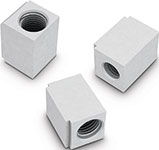
Würth Elektronik eiSos achieves this balancing act between miniaturisation and low contact resistance with its REDCUBE SMD terminals. Whether loosely by hand or fully automated and time efficient from the belt, these wire-to-board or board-to-board connections can even be used vertically, with the SMD terminals able to carry currents of up to 70 A.
The best of both worlds
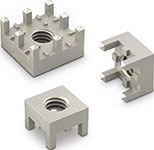
Würth Elektronik eiSos developed the REDCUBE THR series for applications with high vibrations (THR = through-hole reflow, also referred to as pin in paste (PiP)). It combines the benefits of THR technology – primarily its high mechanical stability – with the fully automated assembly option and the efficient reflow soldering process. The processing of these THR terminals integrates seamlessly into the SMT process, as they can be processed the same as SMD components.
The solid and virtually indestructible REDCUBE THR terminals are available with four, eight or nine pins and can be used for currents of up to 85 A. Thanks to their robust design, significantly higher tightening torques can be achieved during assembly than with conventional punched components.
High current of up to 500 A
Small, compact, high-current terminals that carry currents of up to 500 A? Here, contact resistance poses a challenge – to reduce it, foregoing the soldering seems a good option. Therefore, Würth Elektronik eiSos developed REDCUBE terminals with press-fit technology. For this, robust pins milled from solid brass and the choice of brass (CuZn39Pb3) itself are important.
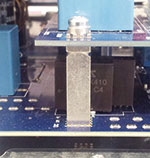
A high-performance, electrical press-fit connection is made by plugging the pins of a REDCUBE PRESS-FIT terminal into the plated through-holes of a circuit board. This creates a gas-tight electrical connection. The surface of the pins was especially optimised for the cold welding that occurs during the press-fit process. The distinctive feature of a press-fit connection compared to soldering technology is the creation of an electrical and at the same time stable mechanical connection between the component and the circuit board. The single solid press-fit pin typically has an extraction force of more than 100 N.
Tests have shown that the long-term reliability of REDCUBE PRESS-FIT sets itself apart with the lowest failure-in-time value (FIT) of the connection system – which is up to 30 times better than that of a SMD solder joint. The REDCUBE PRESS-FIT terminals are virtually predestined for electrical and mechanical connection solutions.
The best connection
The properties of a REDCUBE PRESS-FIT connection are fascinating. For a circuit board with 2,4 mm thickness, the press-fit zone has less electrical resistance than the copper pin itself once a solid press-fit pin has been connected to the sleeve on each of the four corners with a connecting angle of more than three degrees. This connection is definitely neither an electrical nor a thermal bottleneck. Normally, the connecting angle is even much higher, which provides a high safety buffer.
No change is required for the circuit board production, as the through-holes for the press-fitting technique are basically produced in the same manner as those for holding THT components. For press-fitting, the circuit board thickness should ideally be between 1,6 and 3,2 mm. Tested surface treatments are chemical tin-plating and hot air tin-plating (HAL as well as lead-free HAL). Particularly for a circuit board thickness over 2,4 mm, W rth Elektronik eiSos recommends chemical tin-plating, as this process generally ensures that the tin spreads evenly in the sleeve. This makes it easier to meet tolerances.
High current carrying capacity
The REDCUBE PRESS-FIT terminals can carry currents of more than 500 A to the circuit board. In comparison to a soldered joint (R = 300 μΩ up to 400 &mu&#Omega;), the press-fit zone has an extremely low contact resistance, down to 100 to 200 μ&#Omega;. Therefore, the limiting factor tends to lie generally with the layout of the connected tracks or the connection of external supply lines to a press-fitted component.
Thus, the current-carrying capacity of a REDCUBE PRESS-FIT terminal always has to be viewed within the context of the overall system. When selecting the individual high-current terminals, many factors such as conducting track thickness, placement on the circuit board, ambient temperature and thermal distribution should be taken into account.
Applications
Compared to soldering, press-fitting offers a great number of benefits. Very thick circuit boards with high copper coating can be processed more easily. Furthermore, two-sided mounting is easily possible, which generally allows for very compact dimensioning of assemblies. Thus, current paths can be shortened, which is very beneficial especially when dealing with very high currents.
In most cases, REDCUBE PRESS-FIT is used to create a wire-to-board connection. However, this is by no means its only application.
Copper bars, for example, can be mounted using the terminals to increase the current carrying capacity, either by press-fitting the copper bars together
with the terminals – this is possible as long as the overall thickness of the circuit board together with the copper bar does not exceed 3,2 mm – or by screwing the copper bar onto the press-fit terminals.
The ‘high-current cubes’ are also ideally suited for mounting fuses. They can also be used for solely mechanical functions, such as connecting circuit board and housing or connecting two circuit boards together. With the two-piece board-to-board connection option, high mechanical stability as well as current carrying capacity of up to 320 A can be achieved.
Screwless press-fitting
Additionally, this latest addition to the product family presents an interesting option for wire-to-board high-current connections, e.g. for applications that are connected and disconnected several times or for installation in small spaces or difficult to access places.
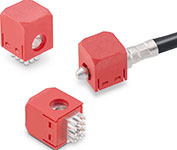
REDCUBE PLUG high-current terminals are literally ‘red cubes’. Here, the cable equipped with a plug is locked into a glass fibre reinforced plastic housing using spring force. A screwless connection is created and disconnected by pressing on top of the housing. A screwless solution can be useful wherever dropping a screw during installation might have particularly serious consequences. REDCUBE PLUGS can carry up to 120 A. The cables are available with cross sections of up to 16 mm².
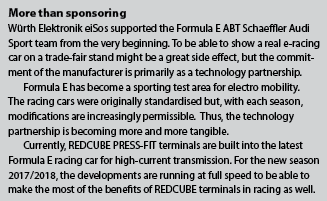
Conclusion
High-current applications are more common than one would think, including e-cars, charging stations, inverters, welding equipment and controllers in drive systems. With the range of REDCUBE components, Würth Elektronik eiSos offers the right product for every application.
Products can be chosen by resistance, heat development and PCB assembly options and especially robust mounts for particularly vibration-resistant connections are also available. The solid brass cubes are a good choice, if one does not want to worry about a reliable low-loss connector for the design of a high-current assembly.
For more information contact Jason Page, Würth Elektronik eiSos, +27 (0)71 259 9381, [email protected], www.we-online.com
© Technews Publishing (Pty) Ltd | All Rights Reserved